During Panchopachar puja, leaves and flowers are offered to a Deity that attract the Principle of the Deity to the maximum extent. For example, bel (Leaves of Aegle marmelos tree) to Deity Shiva and durva (A fragrant grass used in the ritualistic worship of Shri Ganesh) and a red flower to Shri Ganapati. While offering durva to the Idol of Shri Ganapati, the entire body is covered with durva except the face. Durva offered to Ganapati are changed thrice a day. For this reason, puja of Shri Ganapati is performed thrice a day.
Specific Deities must be offered a specific number of flowers and that too arranged in a specific pattern. For example, Shri Ganapati should be offered 8 flowers in rhomboid shape, and Deity Hanuman should be offered five flowers in elliptical shape. These flowers should not placed in an uneven manner.
When offering flowers to the Deities placed in the temple at home, recite the Name of the Upasyadevata (Deity of worship) and then begin by offering small flowers of dark colour, followed by medium-size lighter colour flowers. In the end, offer big white flowers. In a conical arrangement of Deities, only upon offering flowers to Shri Ganapati placed at the apex of the cone, proceed to the next stage; in the second stage, offer flowers to other superior Male Deities. Thereafter, offer flowers to the Female counterpart of the Male Deity, and then to the Deity’s sub-forms.
Do not offer artificial, decorative flowers to Deities; instead, offer fresh sattvik (Sattva-predominant) flowers which attract the specific Deity Principle.
1. Why should we not smell the
flowers that are to be offered to a Deity ?
Flowers have the ability to absorb and emit the Deity Principle. When a jiva smells the flowers, the ichha-shakti (Energy of will) associated with its fragrance in the form of desire enters the subtle chamber of the flower through exhalation. This reduces the functioning ability of the flower. When we smell a flower, the natural Sattva component in it also reduces. Offering such flowers to the Idol of a Deity gives rise to the possibility of the Idol getting charged with Raja-Tama components. This creates an obstruction in the emission of Chaitanya (Divine consciousness) particles that appear in the Idol for the benefit of the devotees.
2. Why are flowers offered to
Shri Ganapati first and then to other Deities
In a conical arrangement, only after offering flowers to Shri Ganapati at the apex of the cone, flowers are offered to the pictures of superior Male Deities at the second level. Thereafter, flowers to the Deity’s Female counterpart or sub-forms of the Deity are offered. Moving from the apex of the cone towards the end symbolises going from dvait (Duality) to advait (Non-duality).
3. Why should a flower be offered with its stalk towards the Deity?
Deity Principle is active in every tree in seed form. When the stalk of a flower offered to a Deity is towards the Deity, the vibrations emitting from the Deity are attracted to the stalk. From the stalk, through the medium of the petals, they are emitted towards the worshipper. The action of the petals here is similar to the blades of a fan. Just as the breeze spreads because of the rotation of the blades, the petals function in a similar manner.
Waves of Deities attracted by the stalk have a greater proportion of nirgun (Non-materialised) waves. When this flow of nirgun waves enters the stamens and petals, the movement of colour and fragrant particles in them convert the nirgun waves into sagun (Materialised) waves with the help of Pruthvitattva (Absolute Earth Principle) and Apatattva (Absolute Water Principle). These sagun waves are emitted towards the jiva through the medium of colour and fragrant particles. Since the physical body of the jiva is made of Pruthvitattva and Apatattva, the waves transmitted through the medium of colour and fragrant particles are easily imbibed by the jiva. These waves do not cause any distress to the jiva. Instead, the jiva is able to imbibe the sagun Chaitanya of the respective Deity to the maximum extent through them.
Various Principles are found united in flowers. It is the presence of Pruthvitattva that imparts fragrance to the flowers. Flowers are visible because they have Tejtattva (Absolute Fire Principle). They can be felt with the hands since they have Vayutattva (Absolute Air Principle). Therefore, we receive the Deity’s Principle, sattvik waves and Chaitanya through the medium of fragrance, touch or even mere sight of the flowers and garlands made from flowers.
Through the picture or the Idol of the Deity, superior level vibrations are emitted; however, the implements or objects used in Deity worship have very little ability to imbibe these vibrations and make them available to the worshipper. These vibrations are emitted for 2 to 3 hours by the flowers that have been offered to a Deity. As the flower becomes stale, there is a reduction in the emission activity.
4. Offering flowers at Deity’s feet as instead of Deity’s head
Nowadays, the custom of offering flowers at the Deity’s feet and offering them on the head of the Deity has become prevalent. When we offer flowers at the Deity’s feet, it helps increase sharanagat-bhav (Spiritual emotion of complete surrender) unto the Deity. Generation of this bhav is important from the perspective of the worshipper’s spiritual progress. Hence, it is appropriate for an ordinary worshipper to offer flowers at the Deity’s feet.
5. Why should buds or dried flowers
or flowers that have fallen from a tree not be offered to a Deity ?
When a flower is in bud form, the colour and fragrant particles are in an unmanifest form. When a bud is about to transform into a flower, the movement of Raja particles in the flower gains momentum. This momentum causes friction and gives rise to warm energy waves that start the transformation of the bud into a flower. Eventually, the colour and fragrant particles of the flower attain a manifest state, that is, they become active. Due to the movement of Raja particles, the waves emitted by the colour and fragrant particles begin to attract the respective Deity’s Principle from the universe towards the flower. When such flowers (charged with Chaitanya) are offered to Deities, they are pleased and they bestow Chaitanya on the jiva. Conversely, when a flower begins to dry up, the movement of Raja particles slows down and it initiates the deterioration of vitality (life force) in the flower. As a result, the ability of the colour and fragrant particles to remain active within such a flower becomes less and the flower gradually dies. Such flowers, that have dried or fallen from a tree, and buds, due to inactivity of colour and fragrant particles within them, become incapable of attracting waves of Chaitanya of the respective Deity from the universe. This is the reason why there is maximum possibility of such flowers being attacked by negative energies or being enveloped with layers of black covering. When such flowers, devoid of Chaitanya, are offered to Deity, the benefit of Chaitanya the jiva gets is minimal. Hence, do not offer buds or dried flowers or flowers that have fallen from trees to a Deity.
6. Which and how many patri should be offered to which Deity ?
It is beneficial to offer the patri (Specific leaves offered during worship) of those flower plants which are favourite of the Deity. Patri is related to the colour particles, whereas the flowers are related to the fragrant particles.
It is necessary to offer five part patri to the Deity. This kind of patri denotes the Panchamahabhutas (The five Cosmic Principles) – Pruthvitattva (Absolute Earth Principle), Apatattva (Absolute Water Principle), Tejtattva (Absolute Fire Principle), Vayutattva (Absolute Air Principle) and Akashtattva (Absolute Ether Principle). By offering five part patri to the Deity, it manifests with the help of the Panchamahabhutas and through the medium of light in a form as required by the individual. The waves emitted by this form are delivered to the individual through the medium ofthe waves emitted by the flowers. That is why, by offering both patri and flowers the individual derives maximum benefit from the ‘sagun’ as well as the ‘nirgun (Non-materialised)’ Principle of God, that is, ofthe radiant Principle. Hence, inclusion of patri and flowers in the ritualistic worship is a must. (Through the medium of Mrs. Anjali Gadgil, 27th April 2005, 5.32 p.m.)
7. Why are the leaves of the Holy basil and bel always pure ?
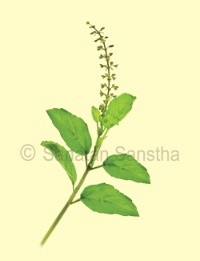 Holy Basil |
 Bel leaf |
The Holy basil originally has 50% Shrivishnu Principle and the bel plant has 70% Deity Shiva Principle. When they are used in the ritualistic worship the Divine Principle in them increases by 20%. The raja-tama in the environment affects every object. The enhanced 20% Divine Principle is used in combating the raja-tama in the atmosphere. The grossly apparent effect of this is that the Holy basil or bel leaves appear dried up or singed. Nonetheless they continue emitting the Divine Principle originally present in them. Hence, the Holy basil and bel leaves are always pure. (Through the medium of Ms. Madhura Bhosale,5th January 2005, 9.11 p.m.)
As the Holy basil emits the Deity Principle constantly, it makes the surrounding environment sacred. That is why a house with a tulasi vrundavan is considered sacred.
8. In ritualistic worship, why do
flowers have more significance than leaves ?
Leaves, related to the Tejtattva, are symbolic of worship of nirakar (God without form); whereas flowers which possess a greater proportion of particles of fragrance along with those of colour, are used more for worship of sakar (God with form).
|
Worship with flowers (Note1) |
Worship with leaves |
|
|---|---|---|
| 1. Symbolises | Sagun worship | Nirgun worship |
| 2. Function | To generate Tejtattva by uniting Pruthvitattva and Apatattva elements | To emit waves related to the Tejtattva |
| 3. At what level of spiritual practice should the individual use it ? | In the primary stage the individual can imbibe the Tejtattva generated in this manner | With the rise in spiritual level the individual can imbibe the emitted waves
|
Note 1 : Flowers are more sensitive than leaves to the absorption of the ‘sagun’ Principle of a Deity; because the former possesses particles of fragrance along with those of colour. Hence, flowers are able to attract the ‘sagun’ Principles of the Deities towards themselves faster than the leaves.

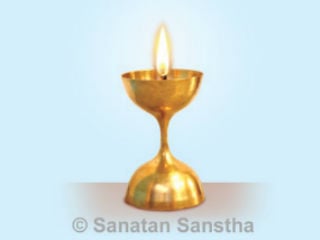 Waving a lit lamp symbolizes puja of Deity with Atmajyoti
Waving a lit lamp symbolizes puja of Deity with Atmajyoti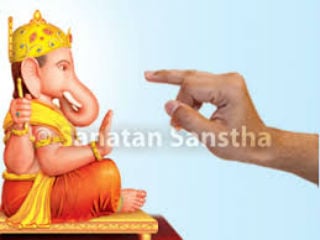 Benefits of applying gandha followed by offering of haldi and kumkum to Deities
Benefits of applying gandha followed by offering of haldi and kumkum to Deities Shodashopachar puja – Means of abiding Dharma in a ritualistic and bhav enriched manner
Shodashopachar puja – Means of abiding Dharma in a ritualistic and bhav enriched manner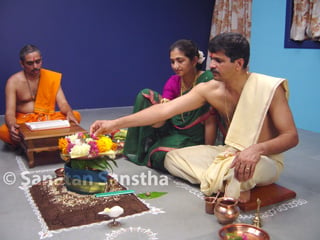 What are the benefits obtained from Puja preparations?
What are the benefits obtained from Puja preparations?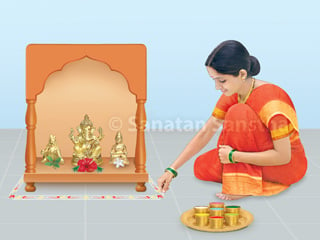 Importance of drawing Rangoli as a part of Puja preparations
Importance of drawing Rangoli as a part of Puja preparations Sounding of a conch at the commencement of a puja
Sounding of a conch at the commencement of a puja